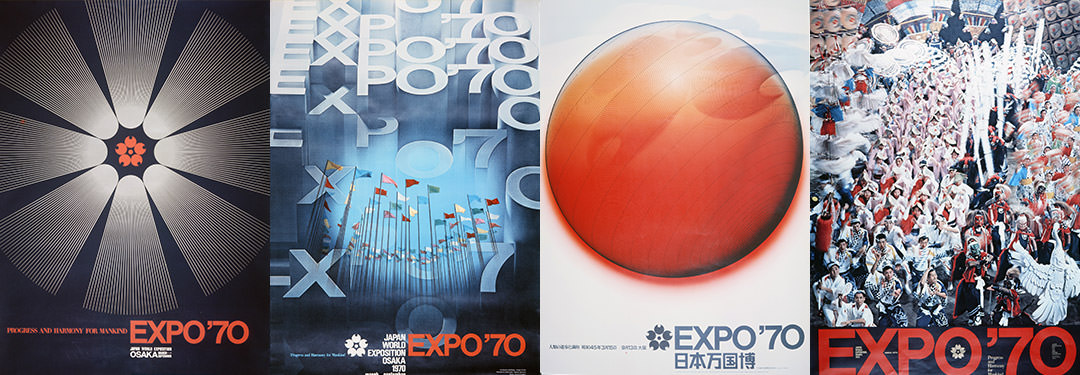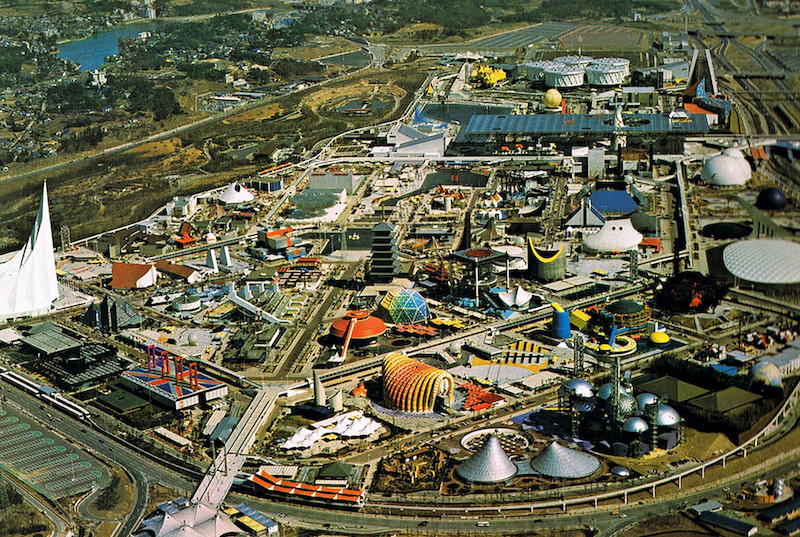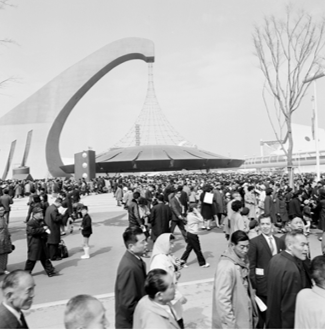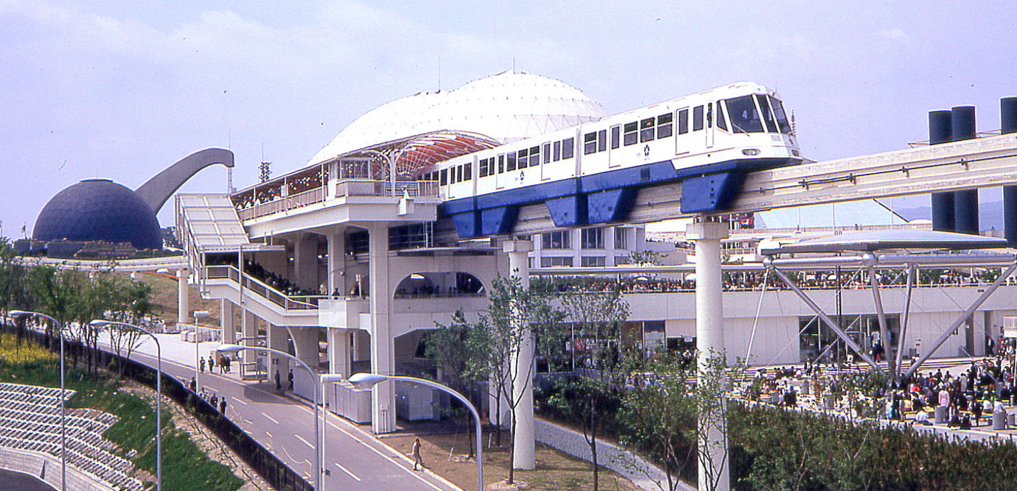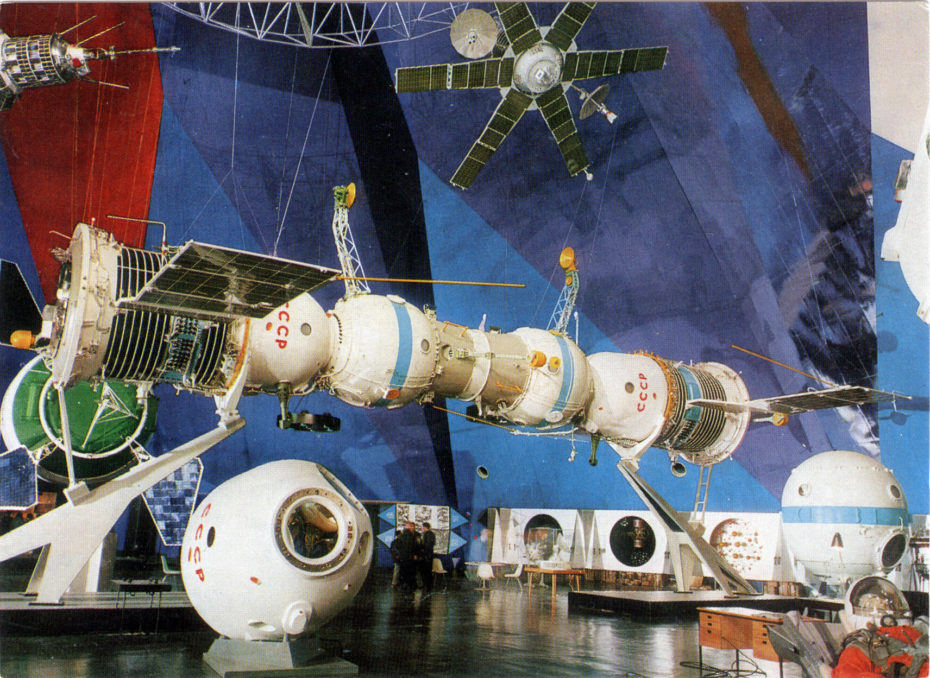Are you finding us from Worldcon?
Join us in Portal 55 (a great deal of DISCORD there…) for weekly broadcasts and perennial discussion!

by Kaye Dee
I’ve recently returned from a trip I never thought I’d get the chance to take – a whirlwind visit to Expo 70 in Osaka, Japan, courtesy of an Australian Academy of Science study tour. As an experience, Expo 70 was such a stunning kaleidoscope of colours and cultures, architecture, artworks and technology that I’m still reeling from all the impressions it left on me!
Welcome to the World of Tomorrow?
Since the 1939 New York World’s Fair, with its “Building the World of Tomorrow” theme and famous “Futurama” exhibition, 20th Century international expositions have helped to imbue Western popular culture with the belief that an amazing technology-enhanced science fiction future lies somewhere just beyond the much-hyped horizon of the Year 2000 – a future filled with superfast trains, flying cars, all kinds of labour-saving household devices, exotic leisure activities and gravity-defying architecture.
Since I never made it to any of the previous post-War world’s fairs – Brussels in 1958, with its Atomium; the 1962 21st Century Exposition in Seattle; the 1964 New York World’s Fair, which offered us “Futurama II”, and Expo 67 in Montreal (the first to be designed to take advantage of global satellite communications via INTELSAT) – I was savouring the opportunity to finally have my own first-hand visit to a world of tomorrow, and one with a Japanese twist. After all, just to get there, I had to take a train from Tokyo that feels like a slice of science fiction itself – the incredible Shinkansen, or bullet train!
So, with the memories of my literally flying visit to Japan to spend three days at Expo 70 fresh in my mind, let me take you on a Journey to the latest world's fair to see if the future unfolds.
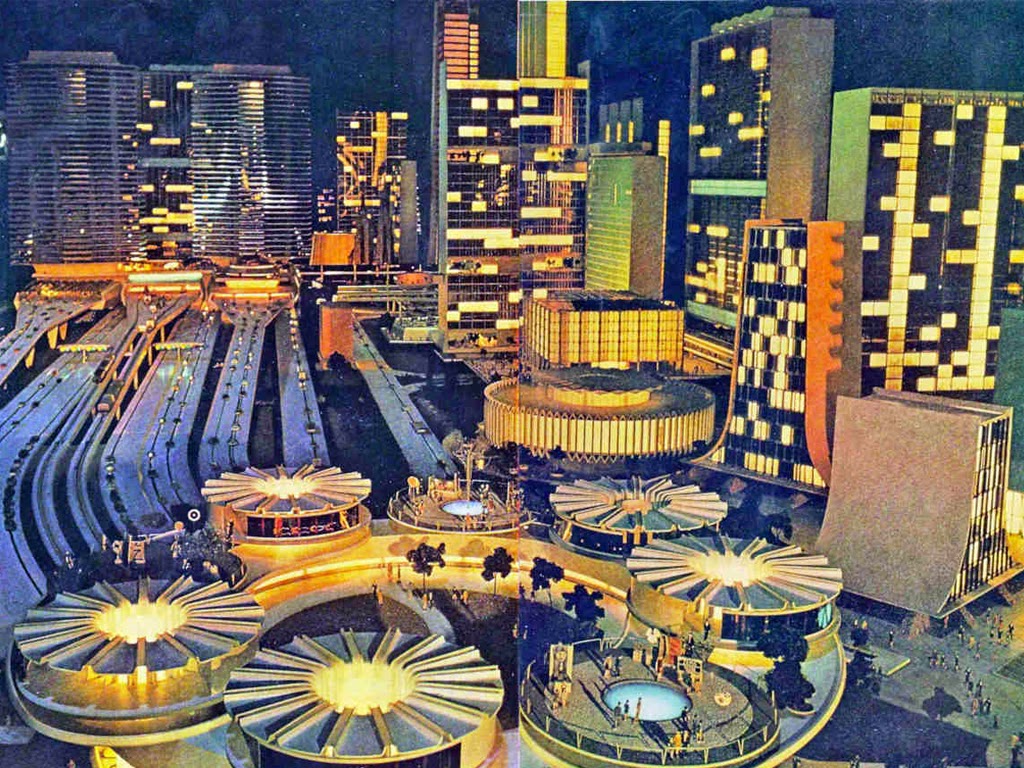 How the Futurama II diorama at the 1964 New York World's Fair envisaged a city in the year 2014
How the Futurama II diorama at the 1964 New York World's Fair envisaged a city in the year 2014
Japan Presents its New Face
A quarter of a century after the end of World War II, Japan’s decision to become the first Asian nation to host an international exposition has been driven by its desire to present a new face to the world, demonstrating its significant leaps in economic and technical development, its societal transformation and the re-creation of the country as a modern Western-style democracy – one which has put aside its militarist past to embrace a pacifist future.
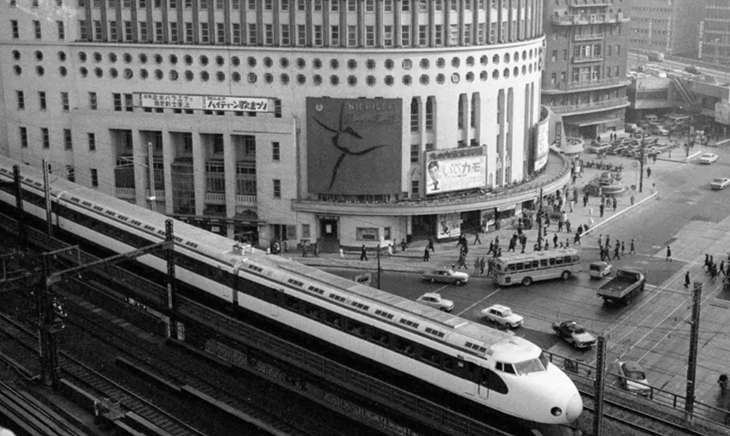 The first Shinkansen speeds through Tokyo. This streamlined super high-speed train, the fastest in the world, has become a symbol of modern Japan since it commenced service in 1964
The first Shinkansen speeds through Tokyo. This streamlined super high-speed train, the fastest in the world, has become a symbol of modern Japan since it commenced service in 1964
This new Japan is beautifully encapsulated in the in the official emblem for Expo 70. Created by graphic designer Mr. Takeshi Otaka, the emblem combines Japanese aesthetics with a modern minimalist style to symbolise the Expo theme of “Progress and Harmony for Mankind”: it is both simple and at the same time complex, carrying multiple layers of meaning.
The overall design is a stylised depiction of the sakura, or cherry blossom, the unofficial national flower of Japan which has profound cultural meanings related to transience, beauty, and renewal – all concepts that resonate within the Expo theme. The five petals of the flower symbolise the “five continents” of the world, expressing the desire for all nations to join hands and participate in the World Exposition. The central circle represents the Hinomaru, the national flag of Japan, while the white background signifies that there is space (ie: opportunity) for development and progress for all.
A Gentler Kind of Future
Expo 70’s theme is less stridently futuristic than Seattle’s “Man and the Space Age”, more aligned with Expo 58’s “New Humanism” and the 1964 World’s Fair theme of “Peace Through Understanding”. This should not be a surprise because, while Expo 70’s creators share the futurist optimism that technological developments can deliver us a better world, they also believe that this should be tempered with a reminder to visitors to be aware that those same technologies create their own shared challenges for the world (such as environmental degradation and overpopulation) which we need to work together to overcome. Otherwise, we could find ourselves on the path to the dystopian futures that seem to be growing in popularity in speculative fiction.
 The master plan for the 820-acre Expo 70 park, located about 10 miles outside Osaka, Japan’s second largest city, has been co-ordinated by eminent Japanese architect Mr. Kenzo Tange. It emphasises open spaces, fountain courts, and pavilions that include levels on, below, and above the ground. In keeping with Japanese culture, a large area of tranquil gardens, dotted with tea houses and rest areas, provides a peaceful retreat from the bustle and activity of the pavilions.
The master plan for the 820-acre Expo 70 park, located about 10 miles outside Osaka, Japan’s second largest city, has been co-ordinated by eminent Japanese architect Mr. Kenzo Tange. It emphasises open spaces, fountain courts, and pavilions that include levels on, below, and above the ground. In keeping with Japanese culture, a large area of tranquil gardens, dotted with tea houses and rest areas, provides a peaceful retreat from the bustle and activity of the pavilions.
Underlying the master plan are two main ideas: that the expo is a place for people of all nations to join in constructively considering the responsibilities of progress in a rapidly changing world; and that the event is not just a venue for contributing nations to display their national achievements, but more a “festival of Humanity”, promoting goodwill and joyous sharing of cultures. This expo asks the visitor to envisage a gentler kind of future, where we can stop and smell the flowers before boarding the monorail!
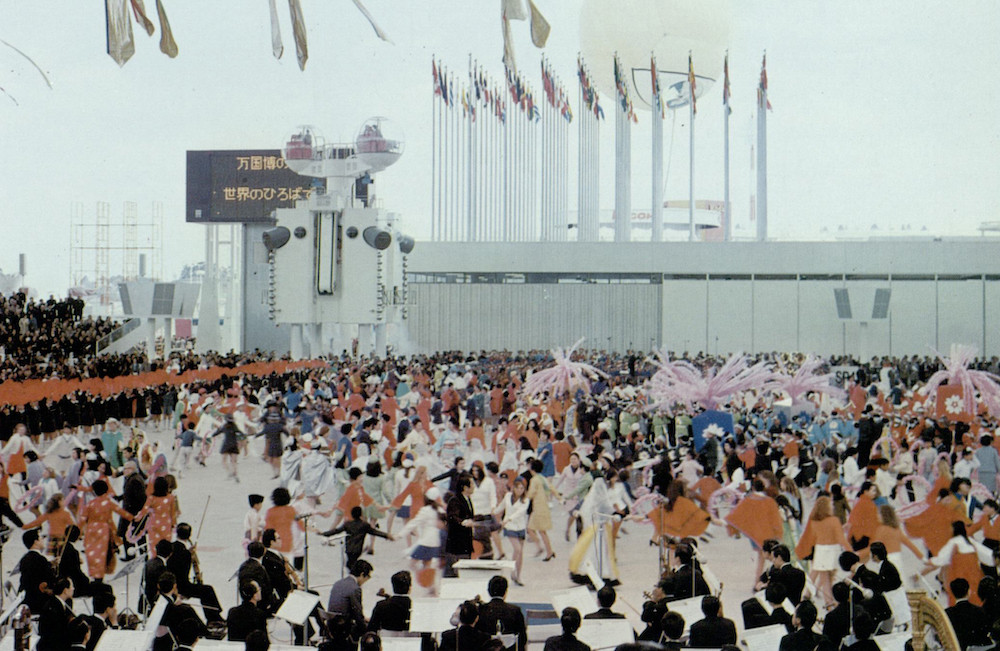 A festival of dance in the Festival Plaza, with the Entertainment Robot in the background
A festival of dance in the Festival Plaza, with the Entertainment Robot in the background
An Aesthetic of Tomorrow
I had no idea prior to my visit that Japan boasted an active and vibrant avant-garde architectural and artistic movement, but it is very much in evidence at Expo 70, as chief designer Mr. Tange is a pioneer of Metabolism. This Japanese architectural philosophy believes that both cities and individual buildings should use advanced technology to grow flexibly and organically in support of its inhabitants' wellbeing. As Mr. Tange told the Academy of Science delegation during our visit, in essence Expo 70 is a Metabolist vision of a city of tomorrow!
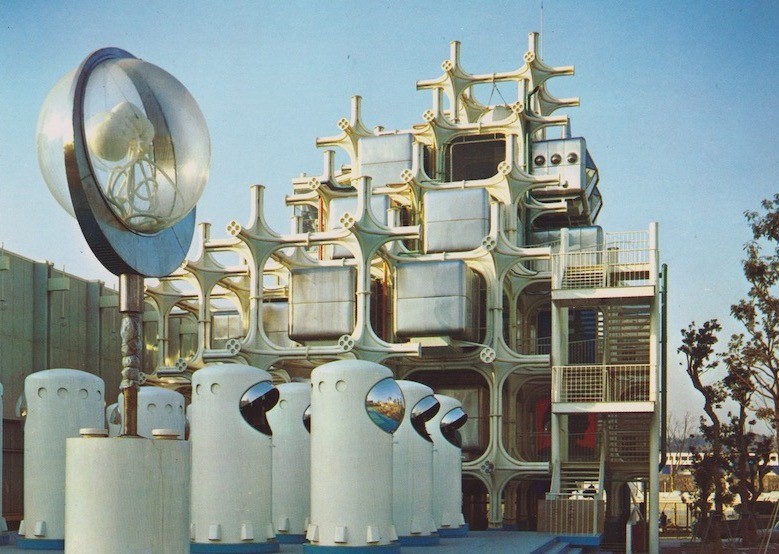 An example of Expo’s Metabolist architecture, the Beautilion (beautiful pavilion) includes an underground interactive theatrical experience, simulating a journey though time and space, spaces devoted to fashion and beauty, and ideas for futuristic kitchens and shopping experiences.
An example of Expo’s Metabolist architecture, the Beautilion (beautiful pavilion) includes an underground interactive theatrical experience, simulating a journey though time and space, spaces devoted to fashion and beauty, and ideas for futuristic kitchens and shopping experiences.
With several Metabolist architects working as Mr. Tange’s collaborators, the futuristic, science fiction style can be found in the design of several pavilions and other structures, in the colour palettes used to denote the functions of different areas, as well as the conceptual “tree” layout of the site’s thoroughfares connecting the pavilions back to the Tower of the Sun, itself a tour-de-force of Japanese artistic avant-garde. (The Tower is the trunk of the tree, the thoroughfares, the branches and the pavilions, the flowers of the tree). Mr. Tange explained that he conceived Expo 70 as a living organism in which “the constant but dynamic equilibrium of the space was coordinated by a vast central management and control system.”
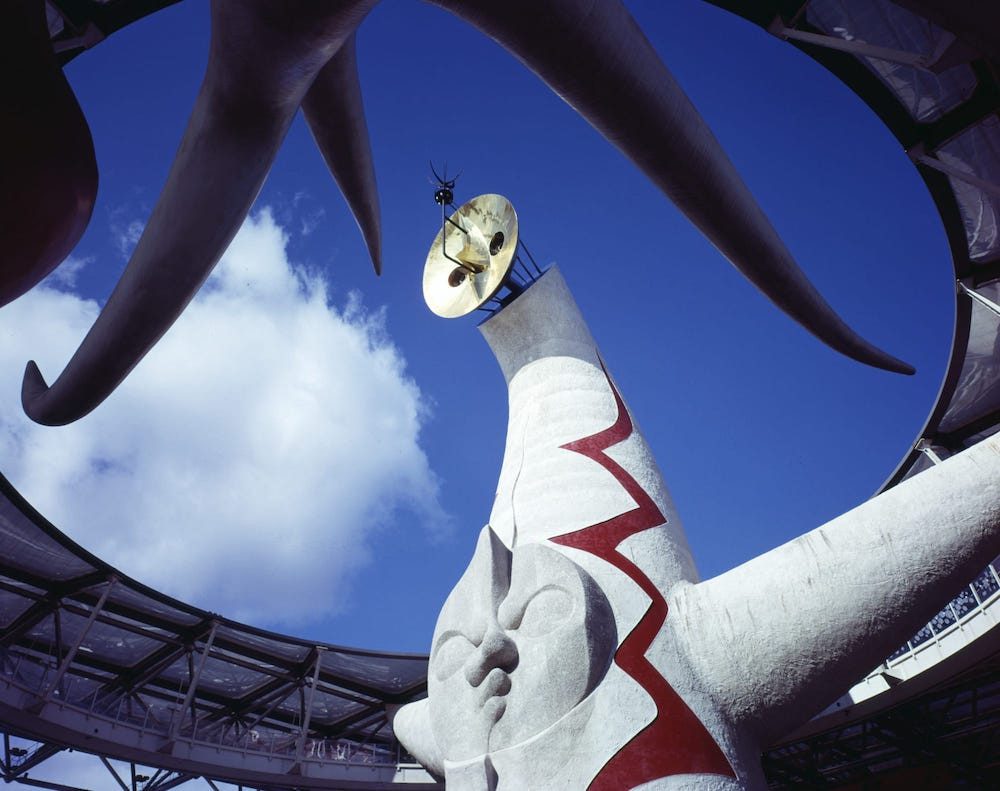 Combining sculptural and artistic elements influenced by Japanese avant-garde art, the Tower of the Sun is both enigmatic and fascinating, seemingly embodying the past and the future
Combining sculptural and artistic elements influenced by Japanese avant-garde art, the Tower of the Sun is both enigmatic and fascinating, seemingly embodying the past and the future
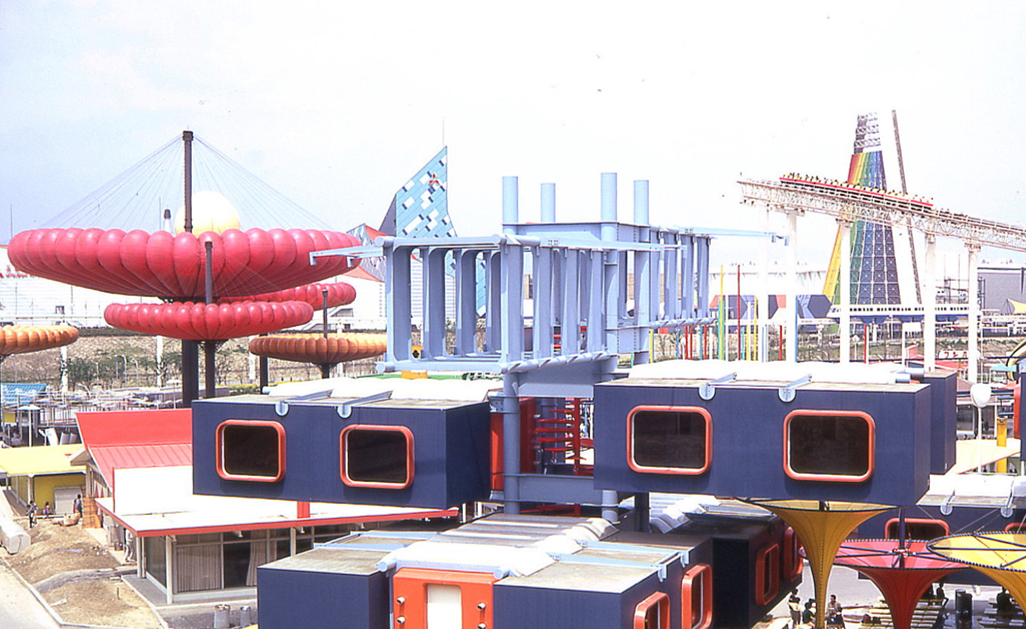 A vista of Metabolist structures at Expo 70
A vista of Metabolist structures at Expo 70
A Space in Time
Arriving at Expo 70’s main entrance, it’s impossible not to be awed by the Symbol Zone, a vast central space intended as a physical representation of the Expo theme. Just as New York in 1939 had its Perisphere and Trylon, Brussels its Atomium, or Seattle its towering Space Needle, the design of the Symbol Zone, the focal point of Expo 70, seems as if it could have been lifted from the cover illustration of an issue of Amazing or Fantastic, with the spectacular Tower of the Sun rising up through the transparent roof of the ultra-modern “space frame”.
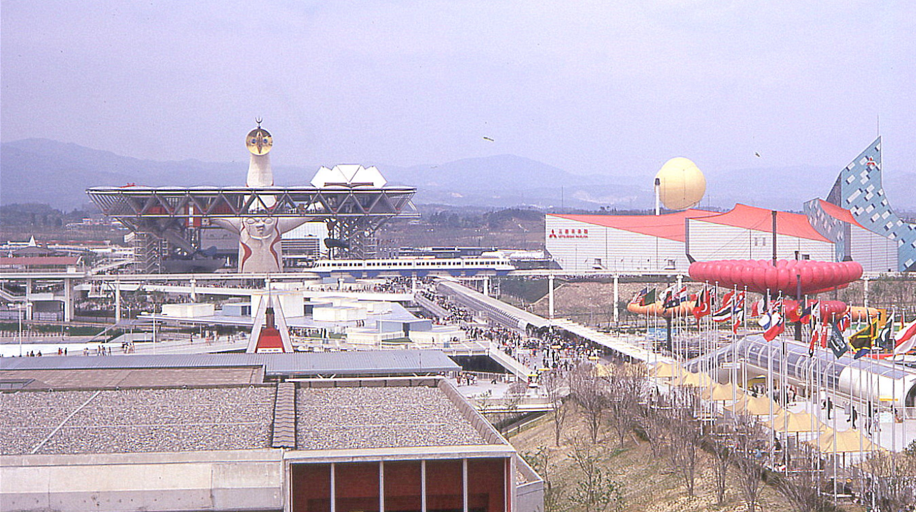
Soaring through the roof of the "space frame", the Tower of the Sun can be seen from across the expo park. You won't get lost as long as you can see it!
Utilising cutting edge engineering design, the metal “space frame” supports the world's first large-scale, transparent membrane roof, which covers the Festival Plaza. Despite its 4,700‐ton weight, the roof seems almost to float 100 feet above the ground, supported across its 960 x 590 ft span by just six latticed columns.
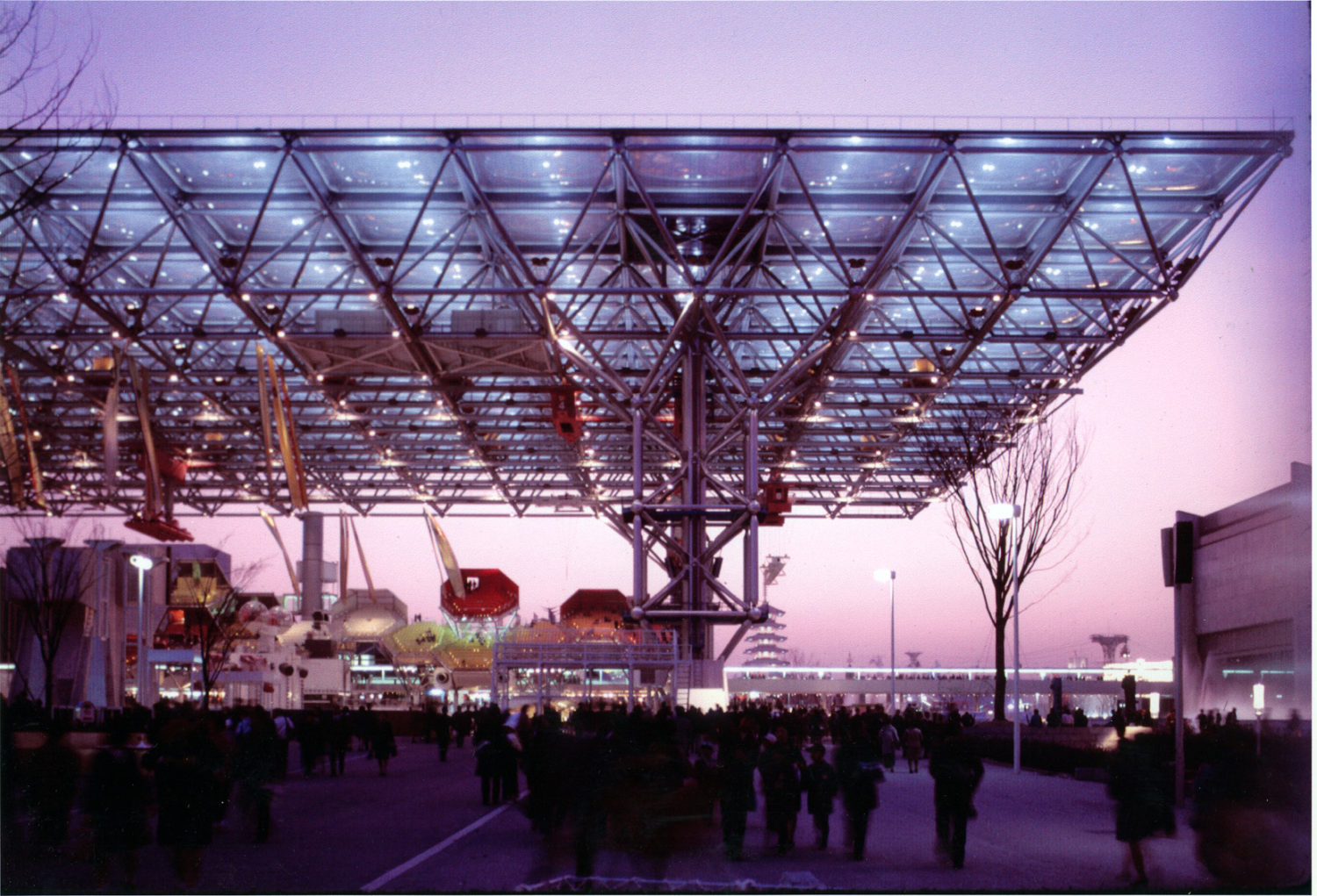 A twilight view of the "space frame", showing its seemingly delicate, yet sturdy, construction.
A twilight view of the "space frame", showing its seemingly delicate, yet sturdy, construction.
Within the Festival Plaza area, people can meet and socialise in a flexible space. It's equipped with the latest audio-visual and lighting technologies and can transform itself to accommodate different types of presentations and seating capacities. Every day is a festival of entertainment, from the Expo opening and closing ceremonies to National Day events presented by various countries, music, dance, experimental electronic soundscapes and more! There’s even an “Entertainment Robot” that can provide a performance area and take part itself! By the time Expo 70 ends, I’m told that 270,000 performers from around the world will have participated in shows within the Festival Plaza!
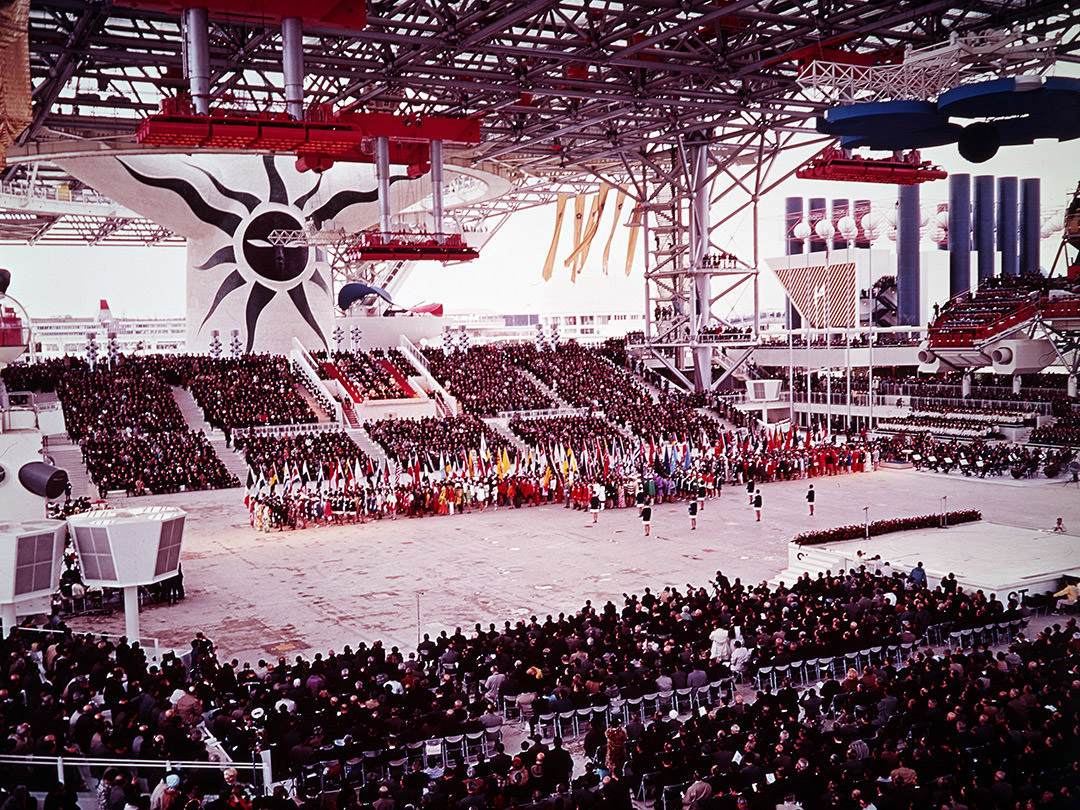 Expo 70 opening ceremony, held in the Festival Plaza on 15 March. The Black Sun icon on the back of the Tower of the Sun seems to preside over the event. Part of the Entertainment Robot can be seen at the left of the photo
Expo 70 opening ceremony, held in the Festival Plaza on 15 March. The Black Sun icon on the back of the Tower of the Sun seems to preside over the event. Part of the Entertainment Robot can be seen at the left of the photo
A Towering Symbol
More visually dominant than even the "space frame" is the soaring Tower of the Sun. This centrepiece of the Symbol Zone stands 205ft tall and serves as the focal point of the entire Expo site, an impressive sculptural artwork, seeming simultaneously ancient, futuristic and otherworldly.
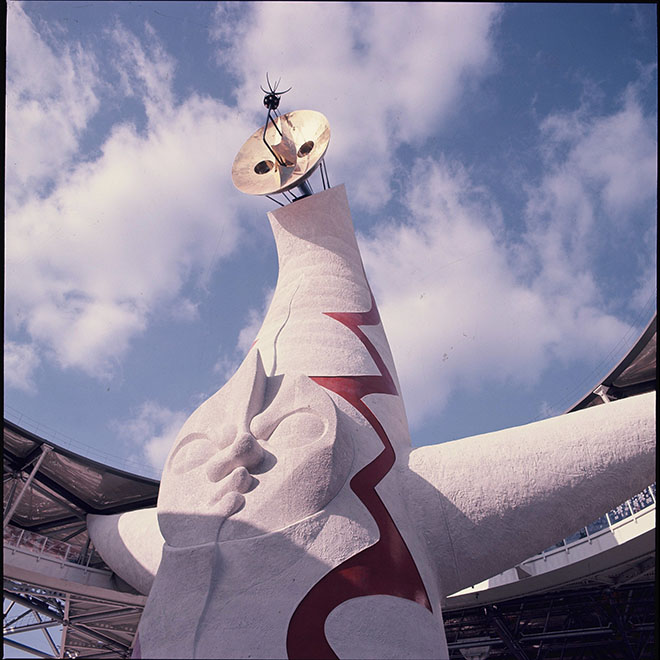 Looking up at the Tower of the Sun to see the golden Sun-face and sculptural "cubist" face
Looking up at the Tower of the Sun to see the golden Sun-face and sculptural "cubist" face
Designed by avant-garde Japanese artist Mr. Taro Okamoto, the Tower represents the “Energy of Life”. It is the symbolic tree at the centre of the Expo design, and also celebrates the Sun as the source of all life. Surmounted by a golden Sun-face suggestive of masks that represent a solar deity in many cultures, it is also decorated along its length with additional Sun-faces. A cubist-inspired sculptural Face at the core of the tower looks toward the Festival Plaza; a more brooding “Black Sun” faces the main entertainment space, and a “Subterranean Sun” lies within the underground exhibition area. The Tower’s design also suggests a mystical being offering outstretched arms to embrace all those who visit the Expo.
 The Tower of the Sun seen from the Festival Plaza with welcoming arms outstretched. Stairways and escalators assist visitors to access the various levels of the Tower and "space frame"
The Tower of the Sun seen from the Festival Plaza with welcoming arms outstretched. Stairways and escalators assist visitors to access the various levels of the Tower and "space frame"
The Tree of Life
Encompassed within the Tower is a series displays referred to as the “Theme Space”, which present the progress of Mankind, from the past to the future. An underground exhibit level, designed by Mr. Okamato, represents the past – the “World of Origins”, with the origins of the human race symbolised by the impressive “Tree of Life” sculpture, reaching up through the interior of the Tower.
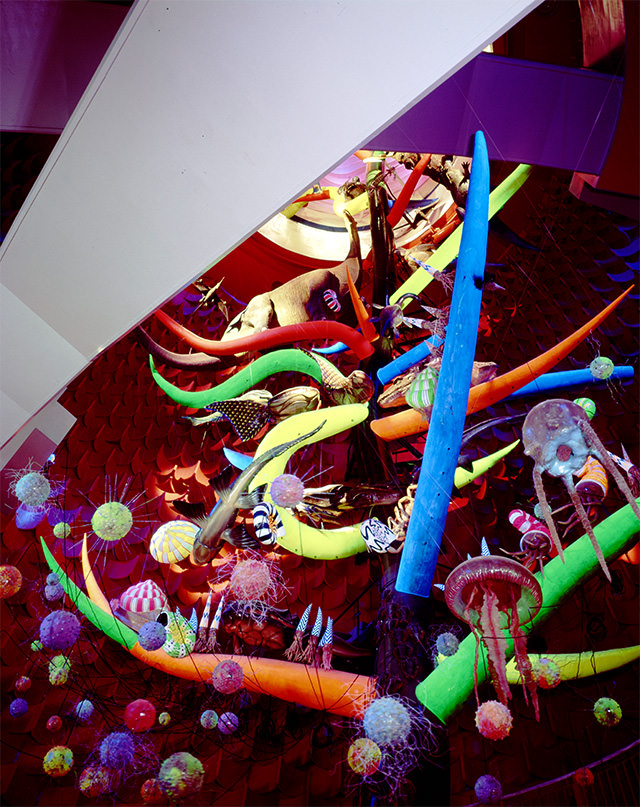 The "Tree of Life" sculpture extends upwards inside the Tower of the Sun. Can you spot the dinosaur?
The "Tree of Life" sculpture extends upwards inside the Tower of the Sun. Can you spot the dinosaur?
At ground level, representing the present – the “World of Harmony” – and again designed by Mr. Okamato, access to moving walkways leading towards different areas of the Expo park symbolises the dynamism of our daily human interactions.
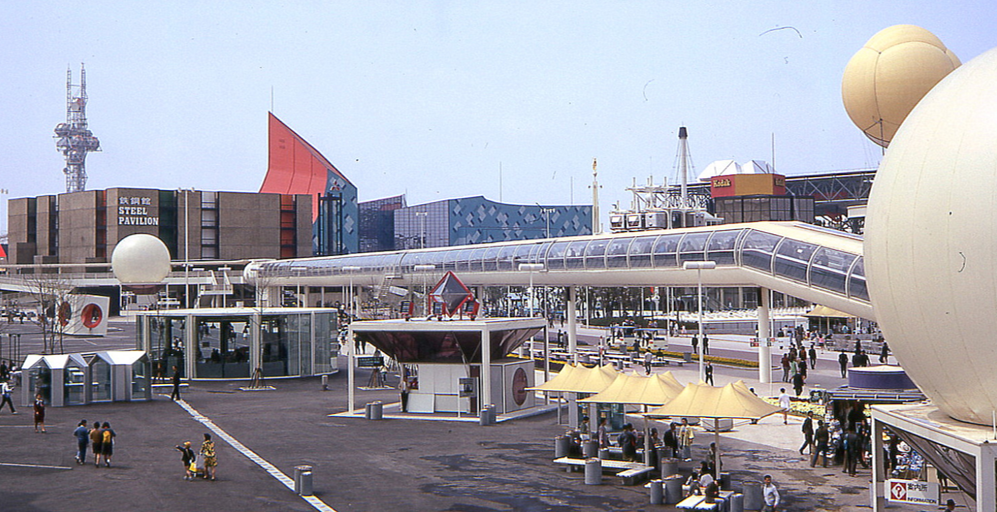 Covered moving walkways save tired legs and help keep visitors out of the sun, as they visit different pavilions
Covered moving walkways save tired legs and help keep visitors out of the sun, as they visit different pavilions
Where the Tower of the Sun pierces the space frame roof, exhibits designed by other avant-garde Japanese artists represent the future – the “World of Progress”. “Capsule rooms” attached to the "space frame" roof present ultra-modern living in a future aerial city, supplemented with additional exhibits on modern urban design in the vicinity of the Tower.
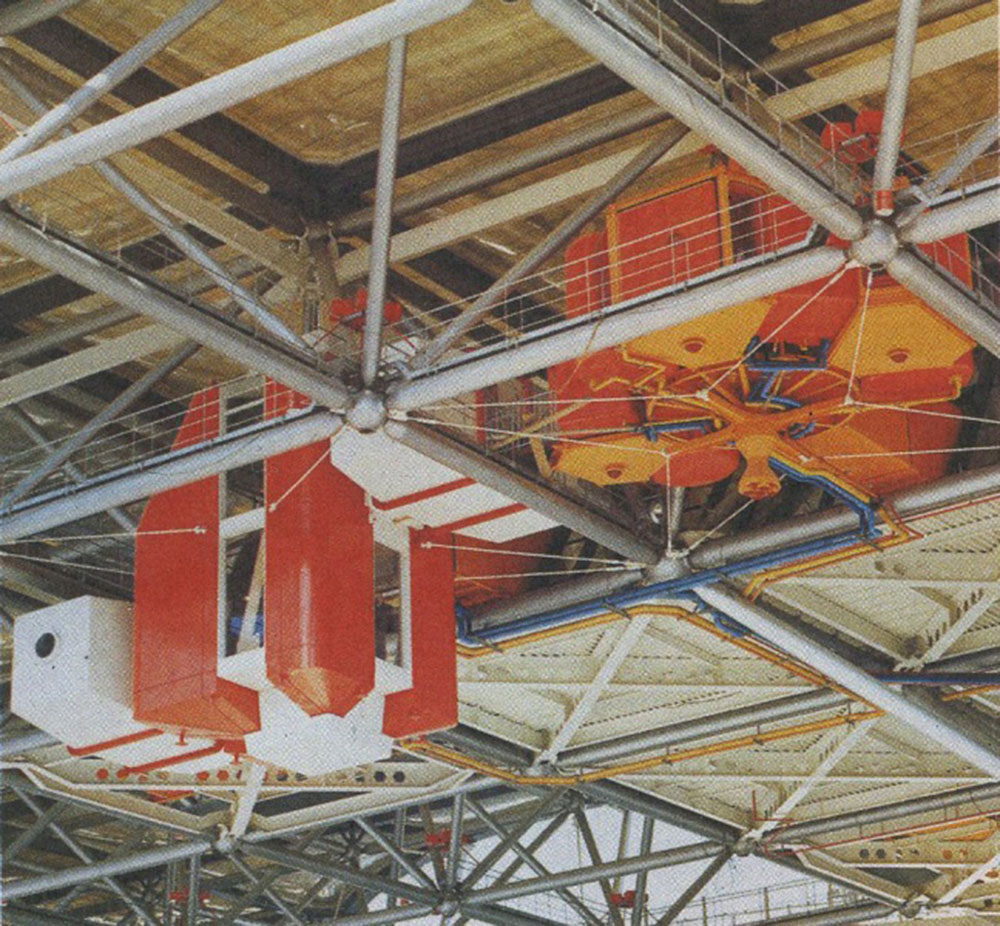 The orange capsule rooms tucked away in the "space frame' aren't suitable for anyone with a fear of heights!
The orange capsule rooms tucked away in the "space frame' aren't suitable for anyone with a fear of heights!
A Microcosm of the World
Previously an area of bamboo forest, the Expo park has been transformed into a vibrant showplace for 116 exhibit halls, as well as performance areas, galleries, public art (some of it commissioned from leading Japanese and international avant-garde artists), restaurants, and other amenities. There’s even an amusement park, Expoland, which offers families and young people fairground rides and activities, including an incredible five-lane roller coaster!
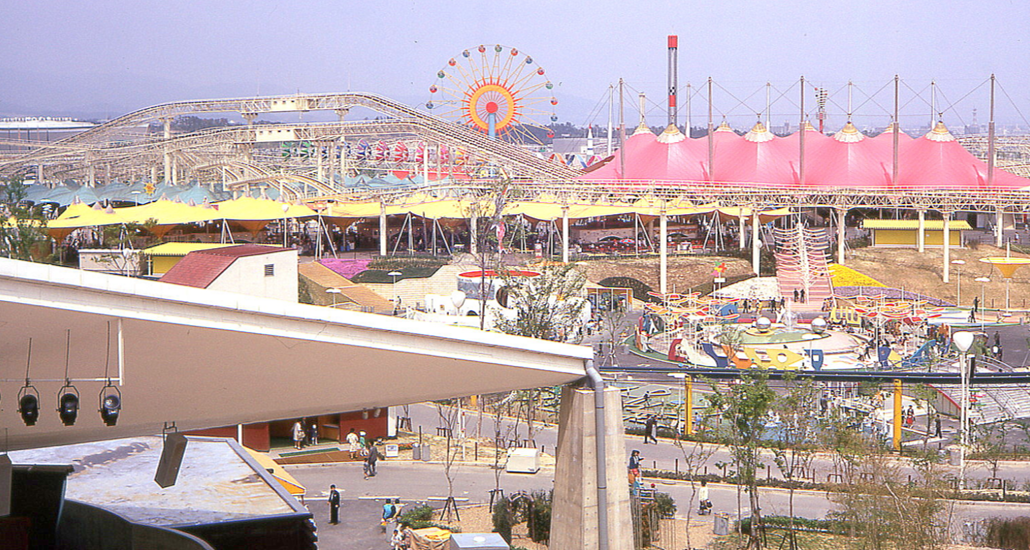 Expoland's amazing roller coaster!
Expoland's amazing roller coaster!
In addition to Japan’s national pavilion, and the exhibit halls of 32 other private Japanese businesses and entities, 76 countries (roughly half the nations of the world), 4 international organizations, 1 political office (Hong Kong), 3 U.S. states, 3 Canadian provinces, 2 U.S. cities, 1 German city and 2 international companies are all represented at Expo 70 – presenting a microcosm of the world.
Symbols of Pride
The pavilions of the participating nations, corporations and other entities present an amazing spectacle of varied architectural design, ranging from the nationalist and traditional to the fantastical and futuristic. Each is a symbol of pride, representing and showcasing the culture, technical achievements and international status of the country or entity to which they belong.
 The Thailand pavilion preferred a delicate traditional architectural style, which is almost lost against the surrounding modern architecture.
The Thailand pavilion preferred a delicate traditional architectural style, which is almost lost against the surrounding modern architecture.
Asian and Middle Eastern nations have tended towards the traditional in their pavilion design, or else adopted a modernised form of their traditional architecture, while the current experimentation with inflatable structures as “building materials” for the future is well represented across Expo 70, particularly found in corporate pavilions. The US pavilion, otherwise surprisingly architecturally mundane, boasts an impressive inflatable roof, while the soaring USSR pavilion, the tallest in the park, is a magnificent concrete boast of Communist pre-eminence, crowned by the hammer and sickle!
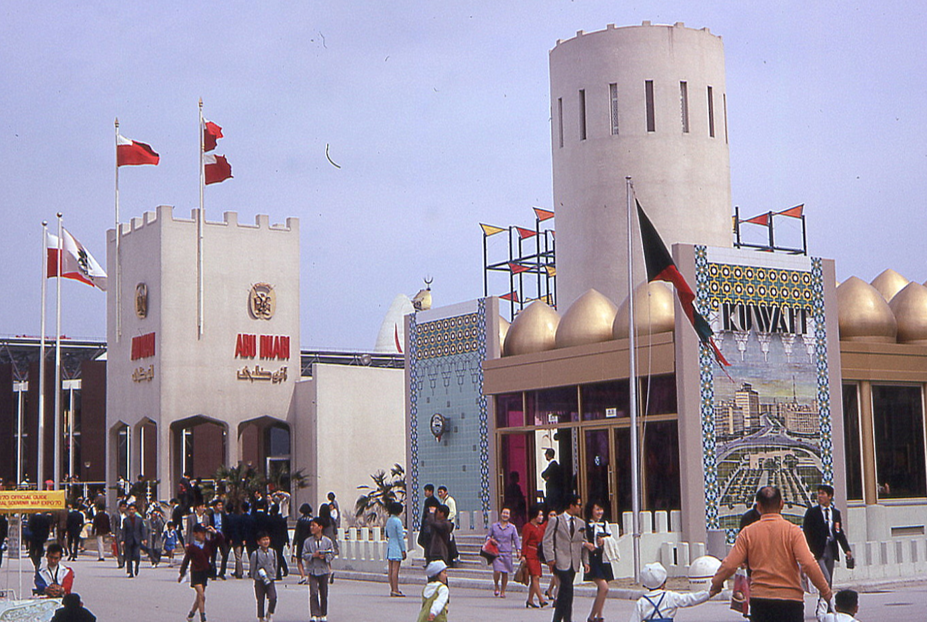 Two Gulf States' pavilions presenting modernised traditional architecture
Two Gulf States' pavilions presenting modernised traditional architecture
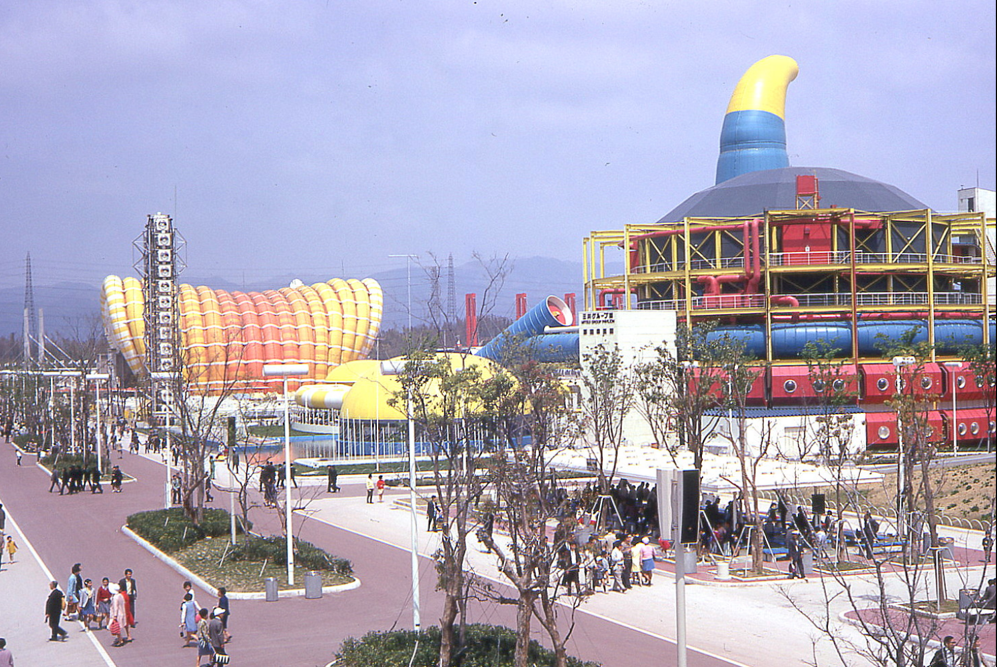 Inflatable architecture in a wild variety of designs has been a popular choice for many Expo pavilions.
Inflatable architecture in a wild variety of designs has been a popular choice for many Expo pavilions.
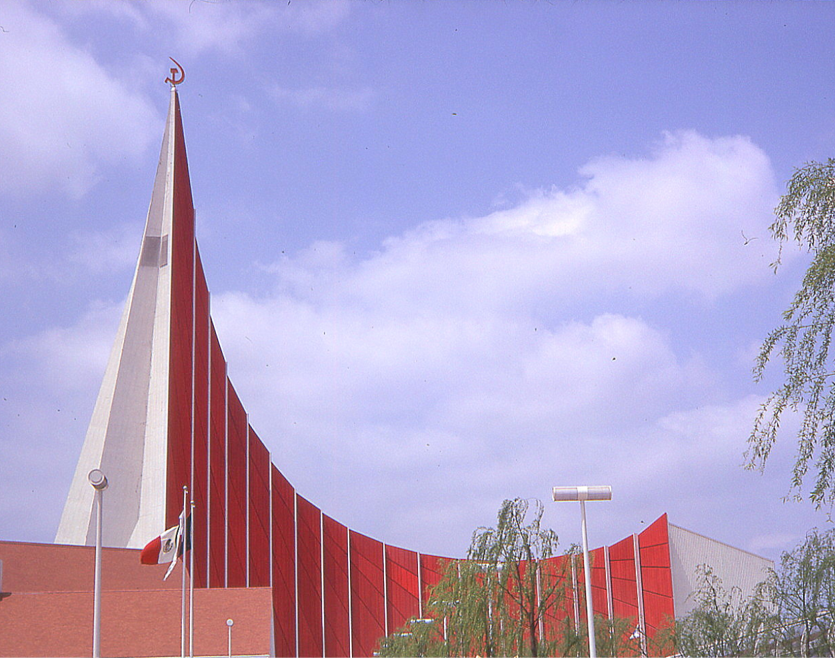 The USSR pavilion is a strident statement of Communist pride and power
The USSR pavilion is a strident statement of Communist pride and power
I’ve mentioned the inclusion of Metabolist architecture and elements throughout Expo 70, but other forms of architectural futurism also abound. The Swiss Pavilion, for example, is a gravity-defying German post-War modernist fantasy that becomes a fairyland of light at night; the Japanese Telecommunications pavilion reminds me of a gigantic spikey caterpillar, like some we have in Australia; the Hitachi pavilion looks like a stereotypical flying saucer, while the Netherlands pavilion is a cubist painting in three dimensions! Japan’s national pavilion echoes the Expo 70 emblem, with five curved halls forming the shape of the cherry blossom when seen from above.

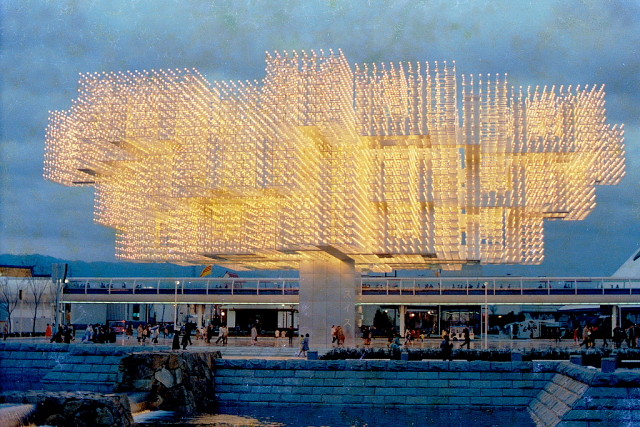 The anti-gravity Swiss pavilion by day and night
The anti-gravity Swiss pavilion by day and night
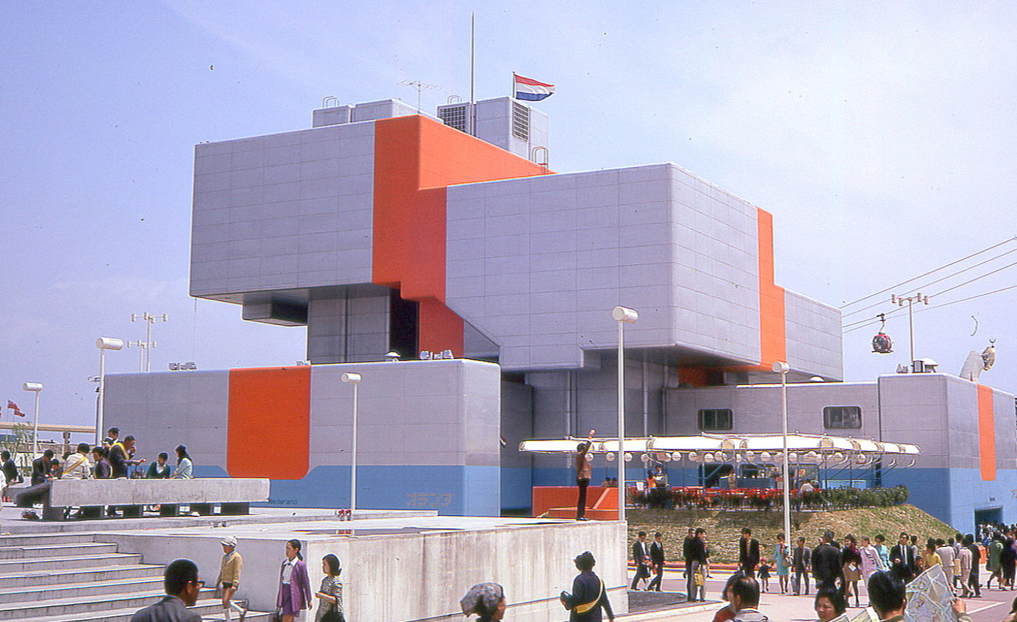 Decorated in the national colours, the Netherlands pavilion makes you think of a Cubist painting
Decorated in the national colours, the Netherlands pavilion makes you think of a Cubist painting
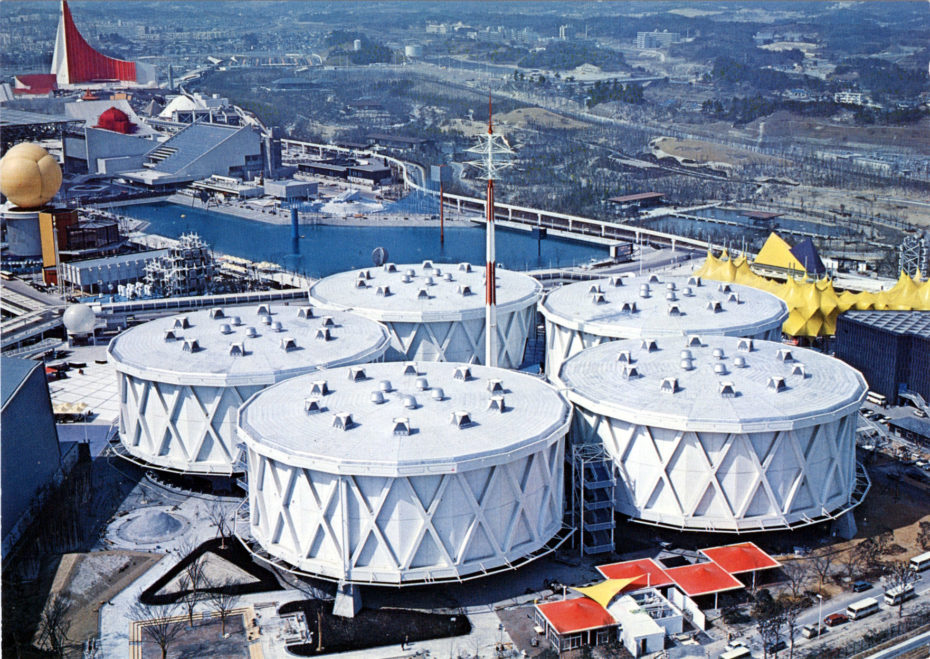 The cherry blossom shape of the Japan national pavilion becomes obvious in an aerial view
The cherry blossom shape of the Japan national pavilion becomes obvious in an aerial view
I could go on forever about the architecture of Expo 70, as I find the many ways in which architects chose to imagine the future fascinating, but I’ll confine myself to one last comment and mention the Australian pavilion. Designed by one of our leading architects, Mr. Robin Boyd, the pavilion is a distinctive fusion of Japanese Metabolism and Australian modernism. The impressive “Skyhook” – which suspends an almost UFO-like roof meant to represent a lotus – has been inspired by the revered Japanese Edo-period artist Katsushika Hokusai’s “Great Wave” painting.
The futuristic elements of the design are matched by the “Space Tube” running alongside the pavilion, in which a moving walkway (another one!) carries visitors past audio-visual presentations portraying Australia’s national and technical achievements. Unlike other pavilions which used local Japanese staff as hosts, we kept a real Australian feel by having Japanese-speaking Aussies as pavilion hosts.
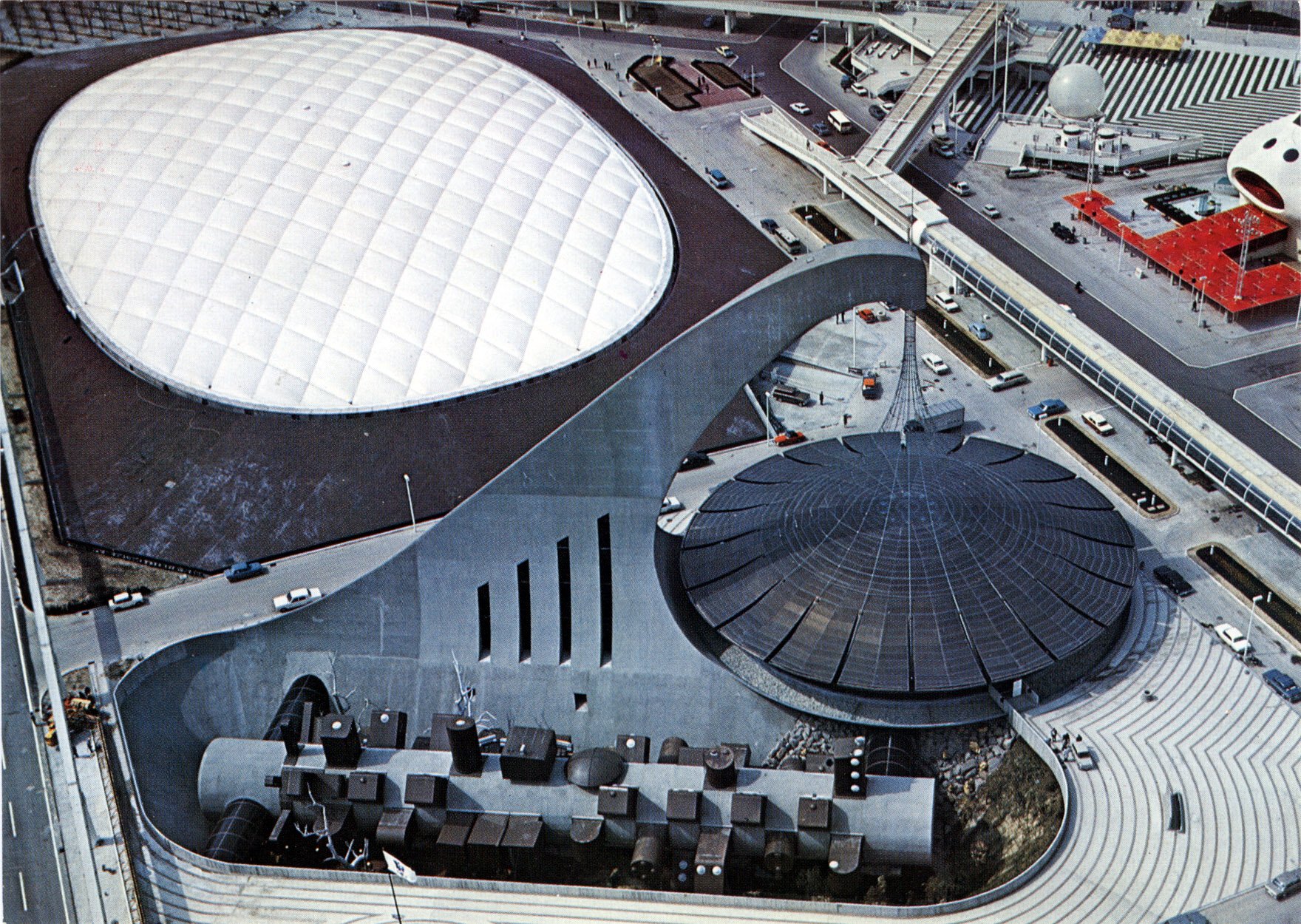 Ground level and aerial views of the Australian pavilion, showing the "skyhook" pavilion design. The overhead view shows the location of the Space Tube, alongside the main pavilion. It also provides a good view of the impressive inflatable roof of the US pavilion
Ground level and aerial views of the Australian pavilion, showing the "skyhook" pavilion design. The overhead view shows the location of the Space Tube, alongside the main pavilion. It also provides a good view of the impressive inflatable roof of the US pavilion
No Flying Cars
I’ve talked a lot about the design and architecture of Expo 70, because it is central to the event creators' philosophical approach to envisioning the future, but what about the more obvious techno-future elements that we associate with modern Expos?
Transportation infrastructure formed an important part of the conception and design of Expo. In addition to the moving walkways I’ve already mentioned, the site is encircled by the now-almost obligatory monorail, or visitors can take to the skies in an overhead gondola ride with suitably futuristic cabins.
But we’ve seen moving walkways and monorails at previous expos, and gondolas are nothing new: where’s my flying car to zoom around the site? Unfortunately, the closest I could get to a flying car was the nifty little “electric jitneys” – small battery-powered golf-cart type vehicles that you could hire for a fee. I rode in one, and while they have only a modest speed, they were surprisingly quiet. It’s interesting to see electric cars making a comeback (after all, they were in vogue about 90 years ago!), with the vast improvements in battery technology. As they produce no polluting exhaust while driving, their use at Expo is clearly intended as part of the environmental consciousness-raising that the Metabolists aspire to, so I wonder if they will become popular in the coming years as a way of reducing air pollution?
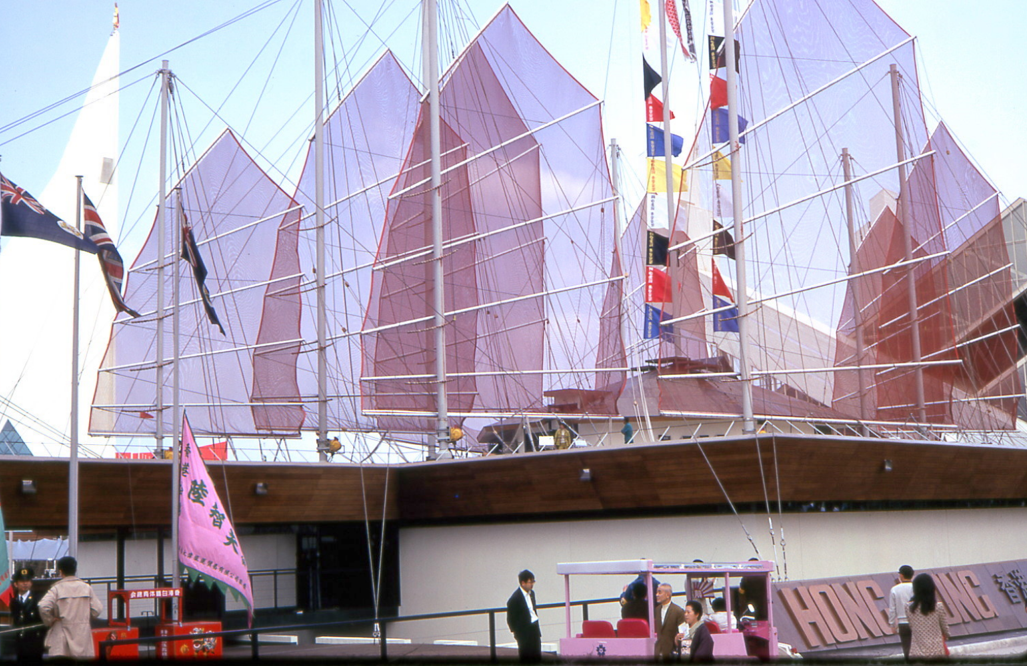 One of the pink electric jitneys in front of the Hong Kong pavilion, with its lovely roof resembling traditional Chinese sailing ships. Visitors can take a jitney, like a taxi, around the Expo park
One of the pink electric jitneys in front of the Hong Kong pavilion, with its lovely roof resembling traditional Chinese sailing ships. Visitors can take a jitney, like a taxi, around the Expo park
There weren’t really any flying cars in evidence in the pavilions, either, but one of the most talked-about exhibits is the 1:20 scale working model of a "Maglev Train," where the carriages travel along a 180-foot track at a little over 12 mph, floating half an inch above the track due to magnetic levitation! Theoretically, a maglev train could cut the four-hour bullet train trip between Tokyo and Osaka to one hour. I wonder how long it will be before we see one in full-size commercial operation? I’d love to zip along at nearly 300mph, riding on a cushion of air!
 The working model of a maglev train on its track in the Japan pavilion
The working model of a maglev train on its track in the Japan pavilion
The “Gadgetiest” Expo
After Expo opened in March this year, I read an article in the New York Times (Thank you New South Wales State Library for keeping up your subscription!) which described Expo 70 as the “gadgetiest” expo to date, and I think that sums up a lot of the technology on display. Much of much of it is only the latest version of technologies that we have already seen introduced over the past few years, with a focus on more practical applications.
There are “Robots” presented across the Expo, especially the Fujipan pavilion, but they are generally little more than advanced animatronics, of the kind already well-known at Disneyland.
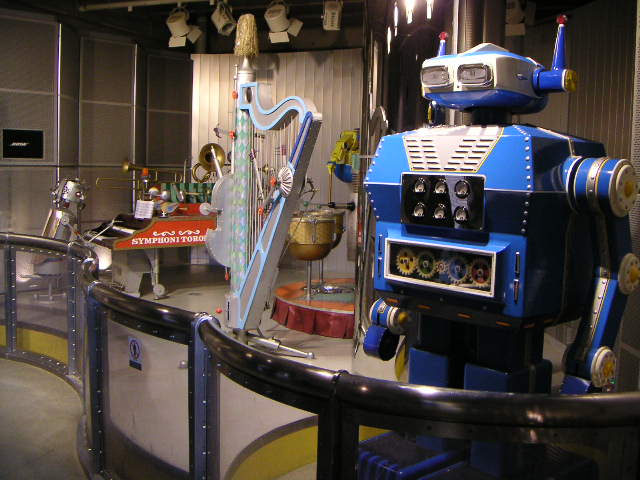 Animatronic robots based on the creations of famed Japanese illustrator and animator Osamu Tezuka in the Fujipan pavilion
Animatronic robots based on the creations of famed Japanese illustrator and animator Osamu Tezuka in the Fujipan pavilion
Holding more potential for the future was voice-activated robot on display in the Furukawa pavilion, which would perform simple tasks in response to vocal commands. The Furukawa pavilion might have a traditional design on the outside, but its thoroughly modern interior also includes a cashless payment system for shopping and an electronic ‘Computer Music Hall’.
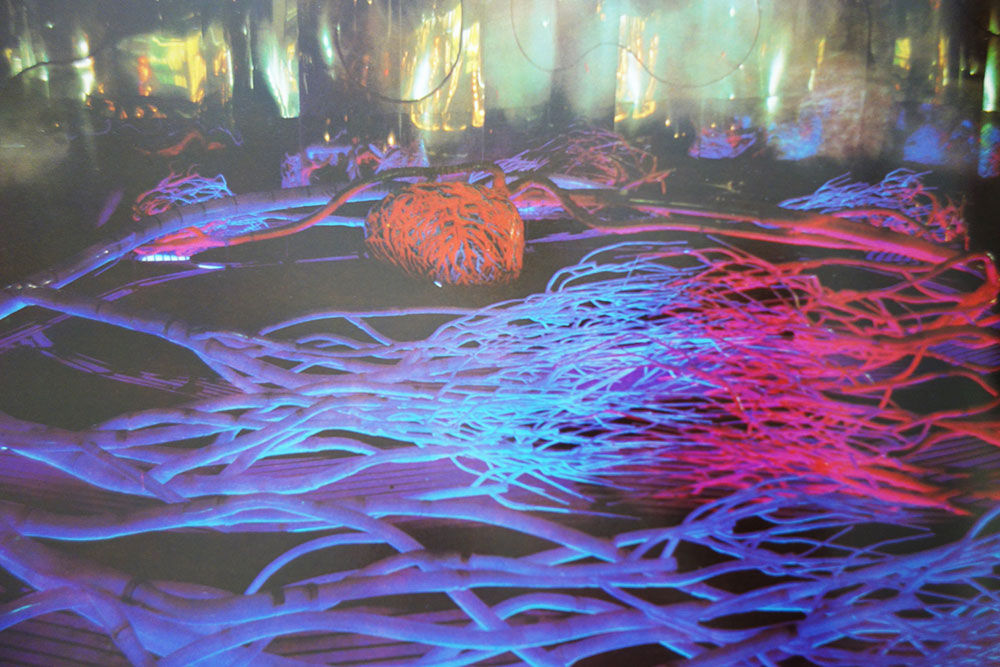 The Garden of Music is an amazing space that uses sound, light and special effects technologies to create an "experience" of music
The Garden of Music is an amazing space that uses sound, light and special effects technologies to create an "experience" of music
I was surprised at the level of displayed technology that was presented as entertainment: there are lasers, astonishing multi-channel sound systems, and even smoke screens to be projected upon (I’d love to see a future discotheque combining all these elements!).
There are also a variety of new multi-screen and split screen cinematic formats on display, including a huge 8-part split-screen 157 ft wide and 16 m 52 ft high that brings to mind the screen walls in Bradbury’s Fahrenheit 451. I was particularly impressed by a new film format presented in the Fuji company’s pavilion. Called IMAX, this Canadian development uses a modified form of 70mm film projected onto a an enormous 59 by 79 ft screen with a tall aspect ratio (approximately 1.43:1). This provides amazing clarity and really draws you into the action on the screen. I suspect the IMAX format will likely have a more commercial future than the Japanese multi-screen technology.
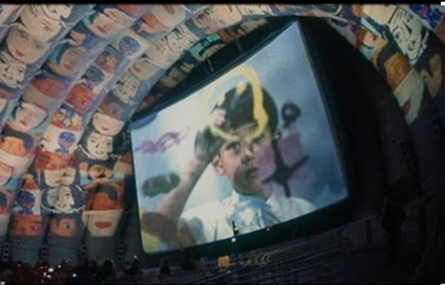 It's hard to convey the impact of the IMAX film in the Fuji pavilion in this photo that I hastily snapped, as photography wasn't allowed!
It's hard to convey the impact of the IMAX film in the Fuji pavilion in this photo that I hastily snapped, as photography wasn't allowed!
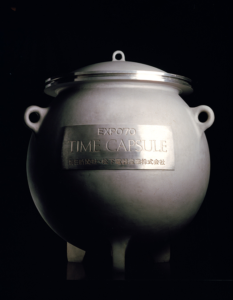 While time capsules are far from new, either, I do want to mention the pair that are on display at the Matsushita Group pavilion, which will be later buried near Osaka Castle. This project, a two-year collaboration between the Matsushita Group and The Mainichi Newspapers has prepared two time capsules, containing a total of 2,098 carefully selected objects representing contemporary Japanese culture. They are intended to be opened in 5,000 years – Japan certainly takes a long view of the future!
While time capsules are far from new, either, I do want to mention the pair that are on display at the Matsushita Group pavilion, which will be later buried near Osaka Castle. This project, a two-year collaboration between the Matsushita Group and The Mainichi Newspapers has prepared two time capsules, containing a total of 2,098 carefully selected objects representing contemporary Japanese culture. They are intended to be opened in 5,000 years – Japan certainly takes a long view of the future!
The items included in the time capsule have been chosen as representative of the natural sciences (including technology), social sciences, the arts, and some souvenirs of Expo 70. Preserved with the best technology available today, the contents even include a record, carefully coated with gold to preserve it, carrying a recorded greeting from Mr. Matsushita himself. This might be an interesting way to send a message on a deep space probe from Earth to any extra-terrestrial race it might encounter on its journey through the cosmos.
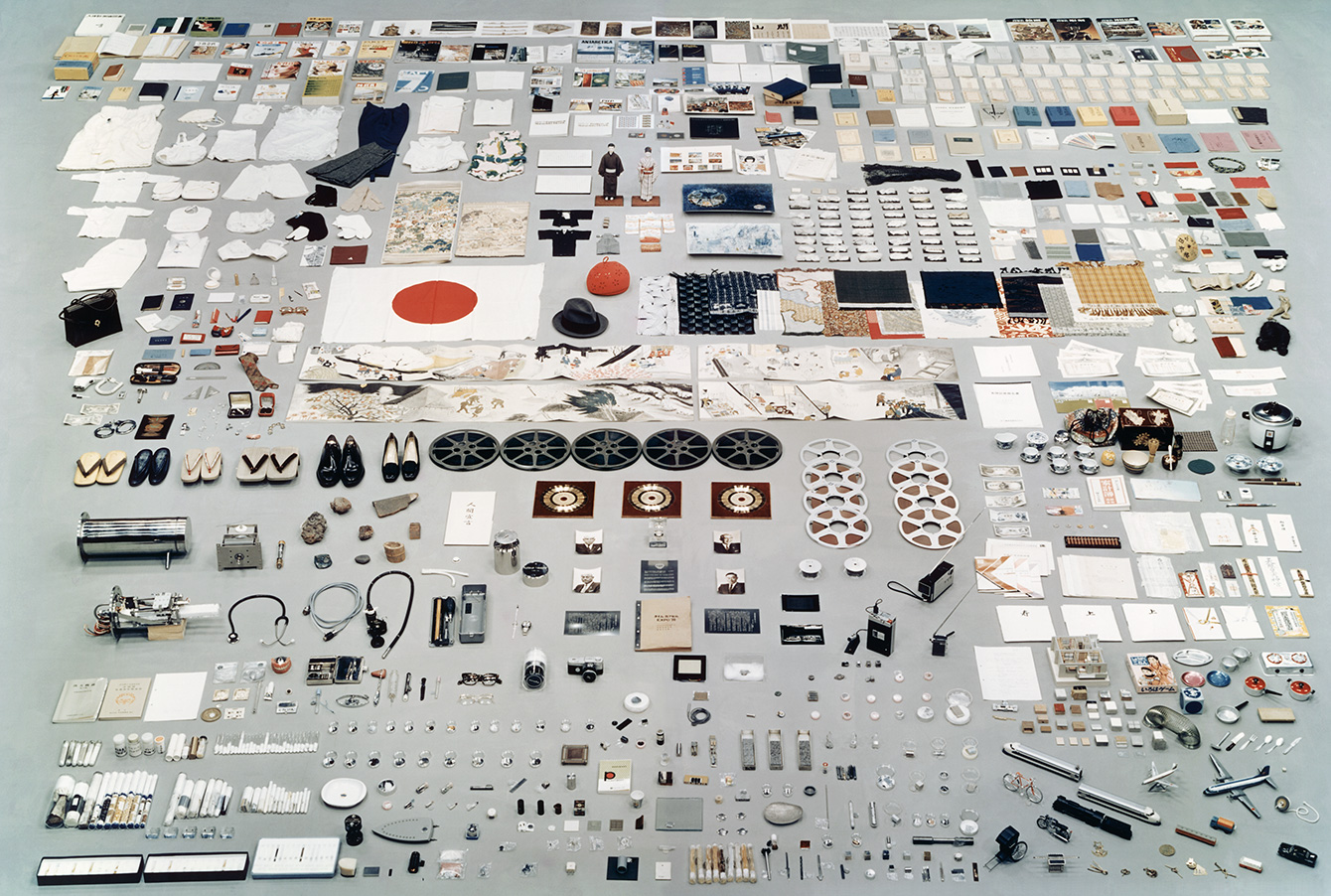 The contents of the Expo 70 time capsules laid out for display. How I’d love to see the world in which these capsules are opened – I really wonder what their archaeologists would make of the contents!
The contents of the Expo 70 time capsules laid out for display. How I’d love to see the world in which these capsules are opened – I really wonder what their archaeologists would make of the contents!
The Space Race Comes to Expo (again)
Speaking of the cosmos, space exploration exhibits have naturally been a fixture at expos since the beginning of the Space Age, and with the Apollo lunar program so much in the news, it's no surprise that space achievements are a major theme in the US and USSR pavilions. Having recently joined the space club, the Japan pavilion's space display also included the tiny chips of Apollo-11 lunar samples that it received from the United States, along with 134 other countries. Perhaps this hints at Japan’s long-term future space ambitions?
However, Japan’s small pieces of the Moon can’t compete with the large chunk of rock returned by the Apollo-12 mission on display in the United States pavilion, alongside the Apollo-8 Command Module, a model of the future Skylab space station and replica astronauts floating suspended around the original Gemini-12 spacecraft! Needless to say, the general fascination with the Apollo missions has made the US pavilion one of the most visited, with people waiting patiently for hours in long queues, just to see these precious artefacts that are science fiction made tangible reality.
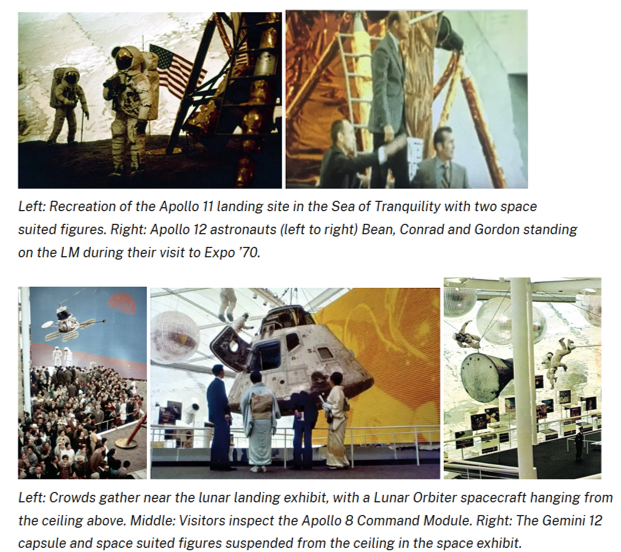 The crowds were too large at the US pavilion to get any good photos of the NASA exhibits, so here's a page provided by the US Information Agency that shows them
The crowds were too large at the US pavilion to get any good photos of the NASA exhibits, so here's a page provided by the US Information Agency that shows them
Not to be outdone, though, the Soviet Union has also mounted an impressive display of full-size or large-scale replica spacecraft and satellites in its pavilion, highlighting recent achievements in its own space program, including the Soyuz-4-5 docking and a full-scale replica of a Soyuz re-entry capsule. Since the USSR is so reticent to release pictures and technical information about its space technology to the world, the space displays in the USSR’s expo pavilions in recent years have provided some of the few opportunities for Western space enthusiasts to get a glimpse of how the Soviets perform their space feats in comparison with NASA.
Coming Soon to a Future Near You!
The reason for my Academy of Science delegation visiting Expo 70 was to look for promising new technologies that might be worthwhile for Australian universities to invest in further research. The results that will go into our report are, of course, confidential, but I’d like to share a couple of the demonstrated technologies that I think hold exciting possibilities for the future.
In the Japanese Telecommunications Pavilion, I tried out a real revolution in communications – a prototype model of a cordless phone terminal! Visitors can try these devices for themselves, making phone calls to anywhere in Japan, so naturally this pavilion is hugely popular. Yes, we already have radio phones in cars, etc, but to be able to have a phone in your pocket, one that you could use anywhere, any time to call anyone – move over Dick Tracy!
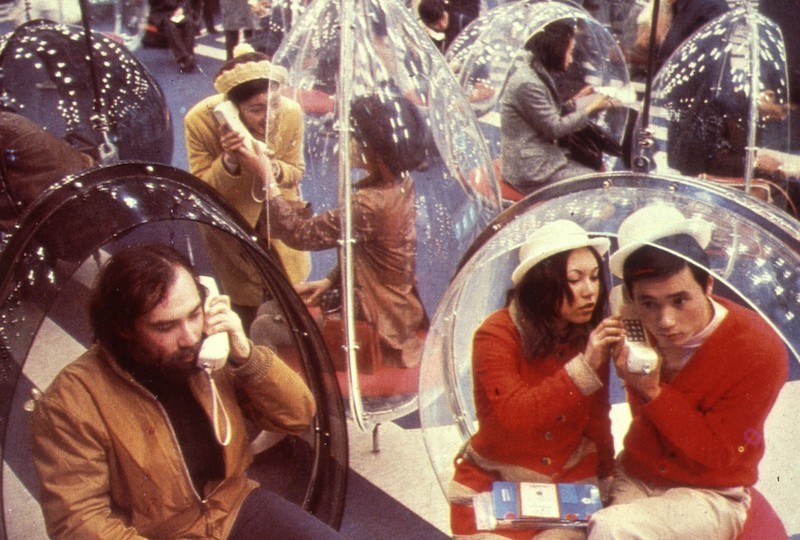 Making a phone call with a wireless phone in the Telecommunications pavilion. I loved the "mini phone booths" that provided some quiet and privacy for the call
Making a phone call with a wireless phone in the Telecommunications pavilion. I loved the "mini phone booths" that provided some quiet and privacy for the call
As electronic computers have become smaller, considerably more powerful and smarter over the last decade, they’ve not only replaced “human computers” like I used to be but are providing us with more versatile and powerful ways to manipulate data. Experts in the field are already talking in terms of information management and information networks. The future world presented in the highest level of the Tower of the Sun includes a model of a “networked city”, where computers are linked together to share information more effectively. Expo 70 itself is an experimental example of a networked facility, with its Operation and Control Centre computers connected to terminals across the Expo park that visitors could use. The Expo computers store approximately 5 million pieces of data, to help keep the logistics and visitor services of the site running smoothly.
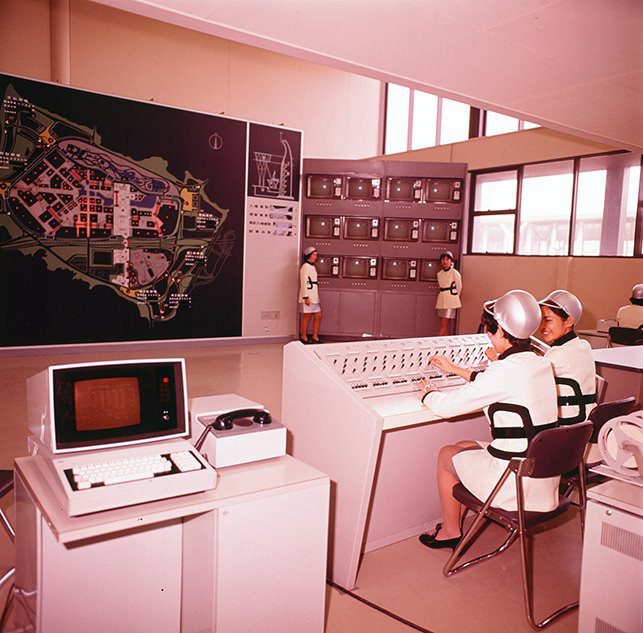 The Operations and Control Centre at Expo 70 has almost enough screens and computers to replace Mission Control in Houston!
The Operations and Control Centre at Expo 70 has almost enough screens and computers to replace Mission Control in Houston!
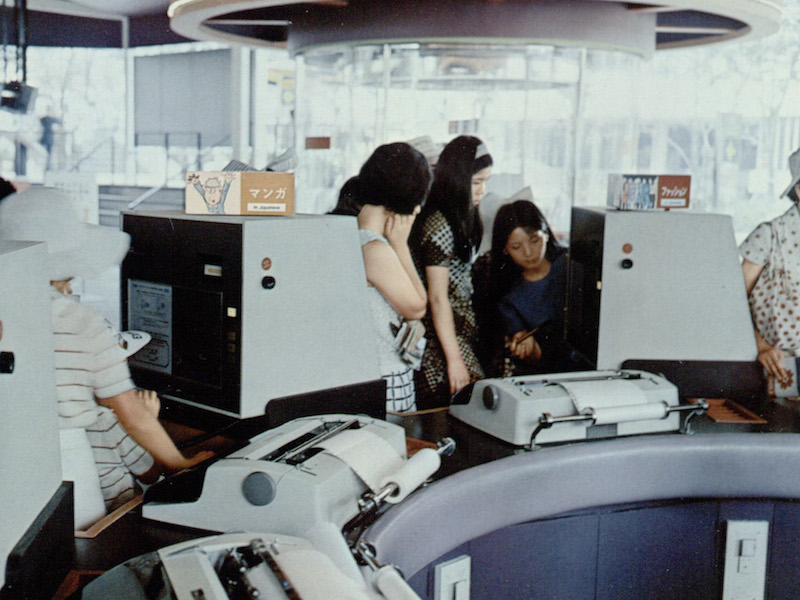 Preparing for a networked future. Visitors to Expo can obtain information using the terminals around the park that are connected to the central information system
Preparing for a networked future. Visitors to Expo can obtain information using the terminals around the park that are connected to the central information system
Have I Seen the Future?
There’s so much more that I would love to share about my visit to Expo 70 – especially about the food! – but just recalling the experiences I’ve shared has made for a lengthy article. Have I seen the future at Expo 70? In terms of the Futurama science fiction World of Tomorrow that is associated with expos, not really. There is a huge array of technology on display, but how much of today's techno-fads will really make a long-term impact on the world? What I have seen, though, is a glimpse of a future where we might be more aware of our natural environment and try to do it less harm through pollution reduction, better urban planning and architectural design; a future where technology might be able to bring us closer together through advances in communications, and the multiplied information processing capabilities of linked computers can help us solve the pressing problems of the world. I think that's a future I’d like to live in.
[New to the Journey? Read this for a brief introduction!]



